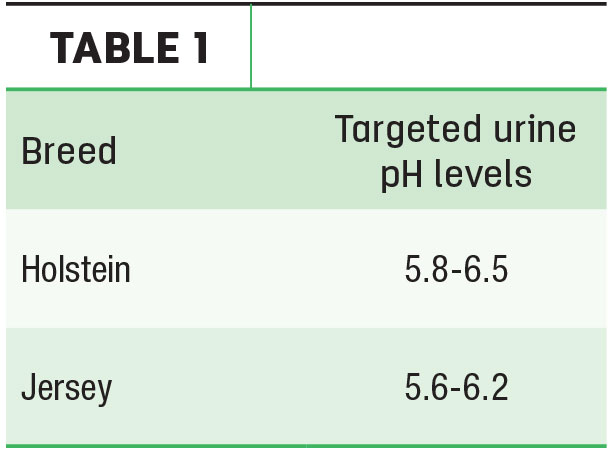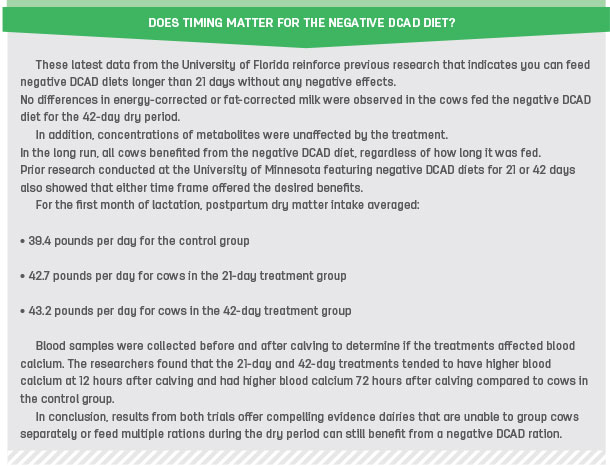Evidence shows feeding a negative dietary cation-anion difference (DCAD) diet of -8 to -12 meq per 100-gram ration dry matter for the last three weeks prior to calving can help prevent a rapid decline in blood calcium around calving and improve cow health and performance in the subsequent lactation.
Thus, negative DCAD has become a management staple in the quest to reduce metabolic challenges like hypocalcemia (clinical and subclinical) through improved nutrition.
That’s because cows with hypocalcemia often experience depressed immune response. They are also susceptible to reduced skeletal and smooth muscle function, predisposing cows to displaced abomasum, metritis, mastitis and other health and productivity challenges.
Some dairies have begun to experiment with the concept that if modifying prefresh ration DCAD a little is good, then modifying it a lot is better. Using this theory, they assume cows will be even healthier and get off to a better start during lactation if they lower DCAD beyond -12. Not so fast.
Recent research conducted at the University of Florida has found it’s not necessary to reduce ration DCAD levels in prepartum diets that low.
Data details
This study, published in a November 2016 supplement to the Journal of Animal Science, shows pushing DCAD levels beyond -12 did not show any positive effects on cow health and performance, meaning it only becomes an added expense.
During the study, the researchers fed prefresh Holstein dairy cows a ration with a negative DCAD of either -7 meq per 100-gram ration dry matter or -18 meq per 100-gram ration dry matter for either the last 21 days or 42 days of gestation.
They assessed daily dry matter intake, urine pH status and analyzed blood samples for several parameters, including blood concentration of calcium.
They found feeding a more negative DCAD diet – regardless of duration – adversely affected key metabolic and performance parameters of blood base excess and dry matter intake. Specifically, data showed reducing the level of negative DCAD from −7 to −18 meq per 100-gram ration dry matter:
- Reduced prepartum dry matter intake by 1.4 to 2.2 kilograms per day
- Induced a more exacerbated metabolic acidosis prepartum
“The negative DCAD diet reduced dry matter intake prepartum as expected,” explains José Santos, research foundation professor, University of Florida Department of Animal Sciences. “That is an anticipated response based on all the literature available.

“We attribute the reduction in intake prepartum with the negative DCAD due to the metabolic acidosis induced by the diet, but that remains to be confirmed experimentally,” he adds. “We are working on an experiment to answer that question.”
Monitor results
Of course, when you monitor urine pH levels as part of your transition management program, there will be some fluctuations in weekly samples of urine pH. That’s normal and no cause for alarm.
Take the samples at the same time of the day to help remove some of the variation from results. Also consider feeding times when analyzing results; when a cow had its last meal prior to testing can influence urine pH levels.
Keep these goals in mind when evaluating and monitoring results: If urine pH is below 6.5 for Holsteins, you will reap the health and productivity benefits of a prepartum negative DCAD diet. There appears to be no justification for trying to achieve lower urine pH values based on postpartum health and production responses. Having lower urine pH values is not an issue necessarily, but there is no reason to strive for them as a goal.
Costly decision
Decreasing ration DCAD to attain urine pH values below the desired threshold adds unnecessary cost to your feed bill. You’ll spend more than is necessary to achieve a more negative DCAD, which does not translate into a more positive outcome.
Calculations show for every two points of DCAD that you decrease the diet, you add approximately 5 cents to ration cost (4 to 7 cents depending on the product price).
When you formulate from a base diet of +18 to a negative DCAD of -8, you shift the diet by 26 DCAD points (from +18 to -8). At 5 cents for every two DCAD points, that will cost about 65 cents per cow per day.
When you adjust the diet from -8 to -10, you add another 5 cents, from -10 to -12 another 5 cents, and so on.
Therefore, if you only need -10 but you are over-formulating for -14, then you are wasting 10 cents per cow per day with no added benefit.
Ultimately, the data suggest there is no apparent reason why you should feed a negative DCAD diet more than -12 meq per 100-gram ration dry matter and DCAD of -8 to -10 appear to do the same job. The only reason to formulate for a slightly more negative DCAD would be to add a margin of safety for those days that forages may change in mineral content due to variability. ![]()
References omitted but are available upon request. Click here to email an editor.

-
Elliot Block
- Research Fellow
- Arm & Hammer Animal Nutrition
- Email Elliot Block







